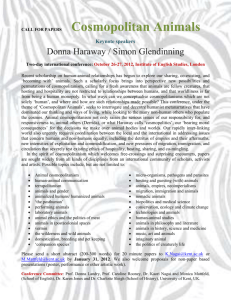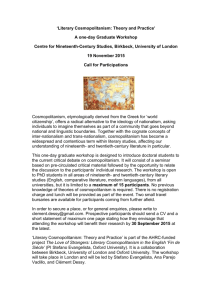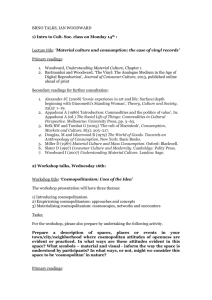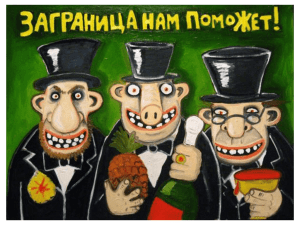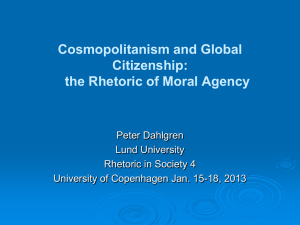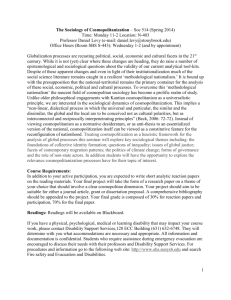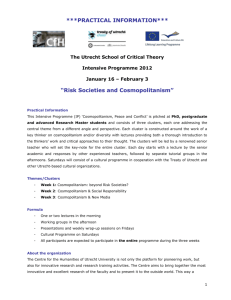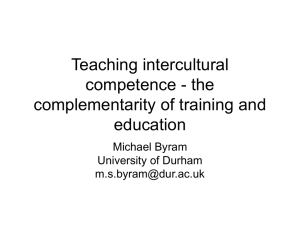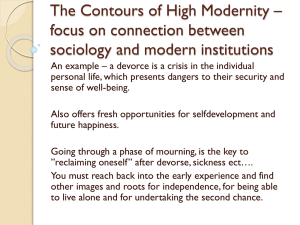cultural studies, history and cosmopolitanism in UK
advertisement
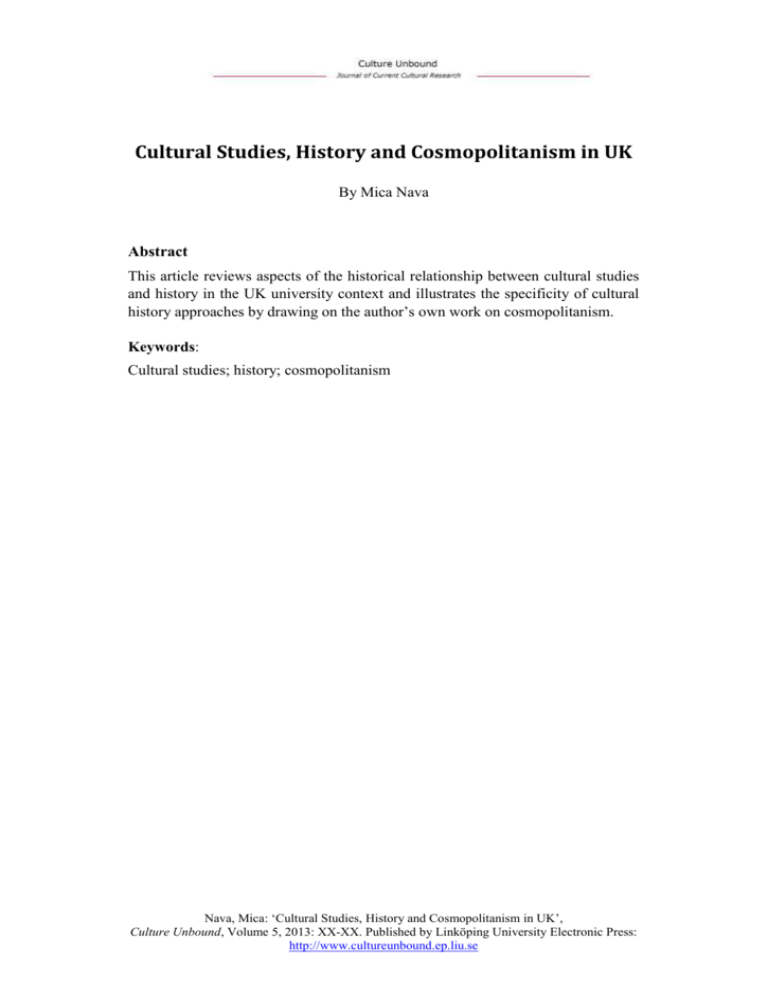
Cultural Studies, History and Cosmopolitanism in UK By Mica Nava Abstract This article reviews aspects of the historical relationship between cultural studies and history in the UK university context and illustrates the specificity of cultural history approaches by drawing on the author’s own work on cosmopolitanism. Keywords: Cultural studies; history; cosmopolitanism Nava, Mica: ‘Cultural Studies, History and Cosmopolitanism in UK’, Culture Unbound, Volume 5, 2013: XX-XX. Published by Linköping University Electronic Press: http://www.cultureunbound.ep.liu.se A History of Cultural Studies In this brief paper I will review aspects of the historical relationship between cultural studies and history in the UK university context and illustrate the specificity of cultural history approaches by drawing on my own research on cosmopolitanism. So, first, a very short history of cultural studies at the University of East London (UEL), the university at which I have worked for three decades. UEL was the home of the first undergraduate Cultural Studies degree in the country, founded in 1981. In those days the programme was not modularised and I arrived when the first intake was in its third year so the broad framework of the course had already been established. What was distinctive about its design was that all students had to do a ‘core’ as well as options in one of three main strands: philosophy, literature or popular culture. Significantly, the core, running through the three-year course, was a more-or-less chronological ‘history’ beginning in the 17th century, so from the start was an indication of the way different knowledges were prioritized. It was influenced by Raymond Williams’ work and focused on the history of class formations and class cultures, ‘race’ and colonial power, women’s lives, popular experience, sexuality, the everyday and the politics of resistance and consent – all the issues you would expect a radical innovative department to be concerned with, but at the time still very unusual. Marx, Gramsci, Foucault, Stuart Hall, Edward Said, Juliet Mitchell, Sheila Rowbotham, Angela McRobbie and Marshall Berman were among the influential thinkers that students (and staff) were expected to read. The teaching group came from a range of disciplinary backgrounds: sociology, history, literature, philosophy and history of art. A few of us had been linked in one way or another to the now celebrated CCCS (Centre for Contemporary Cultural Studies) at the University of Birmingham. All were on the left. Through the collective teaching of carefully planned courses we taught each other and ourselves. In the 1990s we also produced collaboratively a couple of key volumes of essays using this mix of intellectual approaches: The Expansion of England: Race, Ethnicity and Cultural History, edited by Bill Schwarz (1996a) and Modern Times: Reflections on a Century of English Modernity, edited by Alan O’Shea and myself (1996).1 The emphasis on history in our teaching programme and our research meant that from the beginning there was some tension in the group – mostly productive tension – between the ‘proper’ historians – those who had been trained as historians, whose interest and objective it was to ‘uncover’ and piece together features and narratives of the past, particularly of an unfamiliar or hidden past – and those whose disciplinary orientation had been developed in sociology and ‘theory’ and who were more concerned to track the genealogies of the big political questions of Culture Unbound, Volume 5, 2013 [2] the present, that is to say those whose interest was conceptually driven. (For a discussion of these historiographical differences see Eley 2005 and Tosh 2006). In general the direction of the influence between these two broad camps was from cultural studies to history. Over the last decades there has been a tremendous expansion among the more orthodox historians of what counts as acceptable historical source material and how to make sense of it, as well as a more reflexive consideration of the sociopolitical embeddedness and constructedness of all versions of the past. Cultural studies in Britain has had an impact not only on history in its various traditions but on all aspects of the humanities and social sciences – on sociology, geography, literary studies, gender studies, urban studies, language studies, visual culture, media studies, psychosocial studies, philosophy, anthropology, economics, art history and fine art practice (indeed the plethora of ‘studies’ on this incomplete list is itself evidence of this shift). All these are among the established university disciplines in the UK that have been transformed by the more iconoclastic, flexible, interdisciplinary, political and contextual approaches of cultural studies. So does this mean – as Jeremy Gilbert suggested in his written introduction to the spotlight session on British Cultural Studies at the 2011 conference Current Issues in European Cultural Studies – that cultural studies and cultural history have lost their critical specificity and usefulness? Not in my view. Cultural Studies in History: Cosmopolitanism I will use my own cultural historical work to illustrate this claim. There are of course many other appropriate examples but my book Visceral Cosmopolitanism: Gender, Culture and the Normalisation of Difference (2007) is what I know best and it does effectively exemplify the shift in that it doesn’t fit comfortably into any critical mode except cultural studies-cultural history. This is in broad terms because it privileges argument, draws on an expanded archive (sources include ballet narratives, costume design, department store promotions, contemporary fiction, film, photographs, social science texts, media reports, psychoanalytic theory, biography and autobiography – including my own) and, in the tradition of cultural studies, is less preoccupied with adhering to methodological convention than I think are its closest neighbours, history and sociology. It is also an example of ‘British Cultural Studies’ in its thematic focus and its concern with the specificity of postcolonial race relations, cultural difference, gender and everyday life in the UK context. Yet it was not in the first instance driven by existing conceptual concerns despite my rootedness on that side of the methodological divide. My theoretical and historical interest in cosmopolitanism did not precede my work in the archive. In fact at the time there was practically no scholarly research on the topic. I came across it by chance when I was working in the archive of the department store Culture Unbound, Volume 5, 2013 [3] Selfridges looking for evidence of the impact of imperialism on commercial culture before World War One. I found no references to empire at all but a good deal in the founder Gordon Selfridge’s own daily syndicated newspaper columns about how pleased he was that London was losing its insularity and becoming more cosmopolitan and modern. He wanted his store to be at the heart of these changes and publicised the launch in 1909 with full-page advertisements in all the major newspapers in the world welcoming customers in twenty-six languages, among them Arabic, Japanese, Hindi, Russian, Yiddish and Esperanto. ‘All nationalities meet at Selfridge’s and all are welcome’. Advertisement in twenty-six languages from the launch campaign in 1909. Reproduced with permission of Selfridges Archive. Culture Unbound, Volume 5, 2013 [4] As well as being a cosmopolitan moderniser, Selfridge was also an enthusiastic supporter of the contemporaneous movement for women’s suffrage. So this was the starting point of my pursuit of historical manifestations of cosmopolitanism across the span of the twentieth century. Although the concept emerged from the archive rather than an already existing theoretical debate, it was nevertheless shaped by the conceptual material I had already been working on – by gender, the everyday, modernity, and commercial culture. This already-established cultural studies groundwork explains the distinctive focus, argument and conclusions of the book. One of the main concerns of the book was then to explore cosmopolitanism in relation to popular and commercial modernity, to look at its vernacular and domestic expressions. I was interested in the micro-narratives of cosmopolitanism and in everyday personal interaction in the local context, at home, in London, rather than in terms of travel around the world. What emerged from this orientation was an analysis of cosmopolitanism as (following Berman 1983) part of modern consciousness and as (following Williams 1977) a structure of feeling and aspiration. The cosmopolitan disposition in this framework signaled an empathetic, inclusive – albeit semi-conscious and uneven – cluster of identifications with and desire for difference or the 'other', an intuitive sense of self as part of a common humanity with a disregard for borders. This is the 'visceral' cosmopolitanism of the title of the book. The focus is on the allure of difference rather than the repudiation of difference – on antiracism rather than racism. Another main concern of the book, also rooted in the tradition of cultural studies, is its foregrounding of questions of gender and the position of women in relation to this structure of feeling. This question is notably absent from many recent texts on the broad topic. In the book I argue that women were the historical drivers of cosmopolitanism in twentieth century Britain, in part because of their more intimate relationships with the mainly male migrants from abroad and their greater participation in popular modernity through consumption and the movies. I also argue, more contentiously, that women seem to be more disposed to empathise with cultural others. In the book this assertion is supported by literary and historical examples and psychoanalytic theory. The focus in the book on the local prompted me to explore the geopolitical and historical specificity of London. How do the meanings and experiences of ‘multiculturalism’ and epidermal difference differ in London from US cities such as Chicago or other (post)colonial metropolises of the West such as Paris and Amsterdam? What are the differences between UK and other European countries with sizeable intakes of migrant populations? How relevant are the specificity of class formation in the UK and the British privileging of class culture and language to the current outcome? Similarly, and predictably given the concerns of cultural studies with the ‘past’, the book sets out to track the historical development of cosmopolitanism in the Culture Unbound, Volume 5, 2013 [5] UK, particularly in London, from what was an oppositional culture a hundred years ago to the cultural mainstream today, hence to look at change. This is the ‘normalisation’ of my title. I attempt to trace cultural and racial difference from ‘alterity’ to ‘mere difference’. The term alterity (drawing on Sennett 2002 and others) expresses the provoking quality of the unknown unclassifiable other. As the 2012 London Olympics demonstrated, London today is an immensely diverse city in which difference is ordinary. One in three Londoners was born outside Britain and over three hundred languages are spoken by children in London schools. Not only is difference normal, but, as Caribbean-British playwright Kwame Kwei-Armah put it in his radio programme The London Story, ‘London is a city at ease with itself’, ‘proud of its diversity’, it is ‘the California of Europe’, a place which has changed enormously since the 1970s (2010). However, unlike California, London is not only diverse, it is also ‘mixed’. In contrast to the US and elsewhere in Europe, sex and marriage between different cultural groups are now commonplace in UK cities. Although the figures are inevitably contested, it is estimated that about 62% of young males of AfroCaribbean origin under 30 and in a relationship are with white partners or someone from another ethnic group. The figure for young Afro-Caribbean women is about 50%. There is a similar tendency among other ethno-religious and ‘racial’ groups though the figures are lower. It is now estimated that an astonishing 10% of all children born in Britain as a whole (not just in London) come from a ‘mixed’ family (Platt 2009). The cultural mixing phenomenon operates across the class spectrum and includes the Queen’s cousin who is married to a Nigerian. Diana and Dodi are another instance (Nava 2007). These figures are many times higher than in US or elsewhere in Europe. This is the process that interested me when I was writing my book, and indeed continues to interest me today. My focus is thus not so much on plurality and coexistence, or on multiculturalism, or even on super diversity (Vertovec 2007)2 but on cultural mixing, merger, indeterminacy, fusion and mutuality, on 'mongrelisation' as a historical process, on ‘impurity’ and ‘how newness enters the world’ (as Salman Rushdie put it, 1991: 394). Stuart Hall also refers to our ‘mongrel selves’ to suggest the dissolution of old ways of thinking and being (Hall 1992). Mongrelisation is a contentious term but I find it useful in that it evokes process and change. Following Rushdie and Hall I use it in the title of the final chapter of my book: ‘A Love song to Our Mongrel Selves: Cosmopolitan Habitus and the Ordinariness of Difference’. It is important to stress that the book only explores certain aspects of the culture. As I reiterate throughout, xenophobia, racism and racialised imaginings are tremendously significant currents in the history of twentieth century Britain and have co-existed in varying degrees of tension with cosmopolitanism and antiracism. Culture Unbound, Volume 5, 2013 [6] Cultural Studies and Adjacent Disciplines So how, more concretely, does the fact that I locate myself in cultural studies and identify myself as a cultural historian distinguish my work on cosmopolitanism from that rooted in other disciplinary approaches? 1. It is different from the work of sociologists like Ulrich Beck who, despite his focus on the 'cosmopolitanisation' of 'the fundamental concepts and institutions of modern society', does not explore the specificity of different countries, historical change or gender or the quotidian practices and feelings of cosmopolitcs (Beck & Sznaider 2006). My approach is also different from sociologists of cosmopolitanism like Hannerz (1990) and Szerszynski and Urry (2006) who, although more concerned with disposition, focus largely on intellectual and emotional detachment, on seeing difference from afar, not on identification or empathy. 2. It is different on the whole from the work of postcolonial theorists who for very good political and historical reason have focused on the injuries of racial and cultural difference rather than its allure, on racism rather than antiracism (although Stuart Hall and Homi Bhabha both refer fleetingly to the ambivalence and desire which lies at the heart of interracial relations). However, there is some overlap between my ‘visceral cosmopolitanism’ and Paul Gilroy’s notions of ‘conviviality’ and ‘planetary humanism’ (2004). 3. Conventional historians have been ambivalent about the notion of ‘modernity’ and the blending of the textual with everyday culture, as for instance in the eclectic approach adopted by Marshall Berman in his seminal text All That Is Solid Melts Into Air: The Experience of Modernity (1983). The thematic and theoretical concerns of my book and my methodological approach are similarly unconvincing for many historians, though that now seems to be changing. 4. My book also has a different emphasis from the work of the more radical cultural historians whose focus has tended to be on the invention and consolidation of a conservative English 'tradition', on 'conservative modernity', on the legacy of Empire and melancholia about its loss (eg Alison Light 1991; Bill Schwarz 1996b; Chris Waters 1997; Wendy Webster 2005 and contributors to the journal British Cultural Studies writing about the 1950s and 1960s) not on the more positive developments of antiracism and engagement with migrant others. 5. Feminists as well as political economists and sociologists have on the whole not addressed the specific relationship of women to cosmopolitanism (though see Ulrike Vieten 2012 and Nira Yuval Davis 2012). There has been some attention to gender difference in the work on global cities and migrant labour but not much, as far as I am aware, on issues of cultural interaction and the everyday. Culture Unbound, Volume 5, 2013 [7] 6. Psychoanalysts and theorists drawing on the framework of psychoanalysis have been concerned on the whole to explain the unconscious factors underlying prejudice and the repudiation of difference rather than its attraction, see eg Freud (1930/1963) on the 'narcissism of minor differences'. In general there has been very little interest in the psychodynamics of inclusivity and empathy or in gendered differences in response to belonging and cultural ‘otherness’. Ettinger’s theory of the matrixial (2004) is among the exceptions. It is not only a broadly cultural-history interdisciplinary approach which distinguishes my work from that of others concerned with the rapidly expanding topic of cosmopolitanism. There is also the more iconoclastic tradition of ‘arguing against’ which has characterized much cultural studies research from its inception (Williams 1979) and which here has been combined with my insistence on viewing everything through a feminist lens. My perspective has also been influenced by my personal history and psychic formation, an account of which (in the autobiographical chapter on our mongrel selves) I interweave with the main narrative of the book (Nava 2007). This is where I explain my interest in the topic – a contextual element too often missing from most historical accounts which tend to present themselves as somehow unembedded in the vicissitudes of life outside the text. Finally, it is also worth noting that my conclusions and the way I write – the construction of a more progressive reading of British encounters with cultural and epidermal difference in the last century – arise in part from my generally optimistic albeit argumentative disposition. This is not a problem per se, and is not a disavowal of more melancholic readings, but like all factors which influence our understanding of the past and present, needs to be noted. So in conclusion: the general message I want to convey here is that cultural studies in Britain, and especially at UEL, has strengthened ‘history’ and accounts of the past though the boldness and breadth of its themes, archive and method, its use of cultural theory and its consciousness of contextual and biographical factors. Conversely, historical consciousness has also influenced much cultural studies. A questioning of chronology and causal association is likely to yield a more complex picture than is often the case in textual analysis, which is so often the dominant mode in our discipline. We need to contextualise not only our data but also our argument in historical, geo-political and autobiographical terms. As cultural studies scholars we must remember not to invoke and critique theory as though it were produced in a vacuum, without roots. All theorists are people who live at specific historical moments and produce theoretical propositions as part of their engagement with or against other theorists and bodies of thought in specific historical and political contexts. Culture Unbound, Volume 5, 2013 [8] Mica Nava is Professor of Cultural Studies and was founder and co-director of the Centre for Cultural Studies Research at the University of East London, UK. Her publications include Changing Cultures: Feminism, Youth and Consumerism (1992), Modern Times: Reflections on a Century of English Modernity (1996), Buy This Book: Studies in Advertising and Consumption (1997) and Visceral Cosmopolitanism: Gender, Culture and the Normalisation of Difference (2007). She is currently investigating the impact of European and American thinking on ‘race’ relations, gender and cultural mixing in Britain during the 1950s and 1960s. E-mail: m.nava@uel.ac.uk Notes 1 Contributors included Sally Alexander, Andrew Blake, Bob Chase, Catherine Hall, Peter Horne, Alan O’Shea, John Marriott, Mica Nava, Ken Parker, Gwyneth Roberts, Bill Schwarz and Couze Venn. 2 Vertovec’s notion of super-diversity refers to the complex variables, among them class, wealth and education, which disrupt the homogenizing tendencies present in the notion of multiculturalism. But it does not refer to interaction or cultural mixing. References Beck, Ulrich & Natan Sznaider (2006): ‘Unpacking Cosmopolitanism for the Social Sciences: A Research Agenda’, The British Journal of Sociology, 57:1, 1-23. Berman, Marshall (1983): All That Is Solid Melts into Air: The Experience of Modernity, London: Verso. Eley, Geoff (2005): A Crooked Line: From Cultural History to the History of Society, Ann Arbor: University of Michigan Press. Ettinger, Bracha L. (2004): ‘Weaving a Woman Artist With-in the Matrixial Encounter-Event’, Theory, Culture & Society, 21:1, 69-93. Freud, Sigmund (1930/1963): Civilization and Its Discontents, London: Hogarth Press. Gilroy, Paul (2004): After Empire: Melancholia or Convivial Culture, Abingdon: Routledge. Hall, Stuart (1992): ‘Our Mongrel Selves’, New Statesman and Society, 19 June 1992. Hannerz, Ulf (1990): ‘Cosmopolitans and Locals in World Culture’, Theory Culture & Society, 7:2-3, 237-251. Kwei-Armah, Kwame (2010): The London Story, BBC Radio 4 (July). Light, Alison (1991): Forever England: Femininity, Literature and Conservatism Between the Wars, London: Routledge. Nava, Mica (2007): Visceral Cosmopolitanism: Gender, Culture and the Normalisation of Difference, Oxford: Berg Nava, Mica & Alan O’Shea (eds) (1996): Modern Times: Reflections on a Century of English Modernity, London: Routledge. Platt, Lucinda (2009): Ethnicity and Family: Relationships Within and Between Ethnic Groups, London: Equality and Human Rights Commission (EHRC). Rushdie, Salman (1991): Imaginary Homelands, London: Granta. Schwarz, Bill (ed.) (1996a): The Expansion of England: Race, Ethnicity and Cultural History, London: Routledge Culture Unbound, Volume 5, 2013 [9] Schwarz, Bill (1996b): ‘The Only White Man in There: The Re-racialisation of England 1956-68’, Race Class, 38:65. Sennett, Richard (2002): ‘Cosmopolitanism and the Social Experience of Cities’, Steven Vertovec and Robin Cohen (eds): Conceiving Cosmopolitanism: Theory, Context and Practice, Oxford: Oxford University Press. Szerszynski, Bronislaw & John Urry (2006): ‘Visuality, Mobility and the Cosmopolitan’, The British Journal of Sociology, 57:1, 113-131. Tosh, John (2006): The Pursuit of History, London: Pearson. Vertovec, Steven (2007): ‘Super-diversity and its Implications’, Ethnic and Racial Studies, 30:6, 1024-1054. Vieten, Ulrike (2012): Gender and Cosmopolitanism in Europe, London: Ashgate. Waters, Chris (1997): ‘“Dark Strangers” in Our Midst: Discourses on Race and Nation in Britain, 1947-1963’, Journal of British Studies, 36 (April), 207-238. Webster, Wendy (2005): Englishness and Empire 1939-1965, Oxford: Oxford University Press. Williams, Raymond (1977): Marxism and Literature, London: Oxford University Press. Williams, Raymond (1979): Politics and Letters, London: New Left Books Yuval Davis, Nira (2012): The Politics of Belonging, London: Sage. Culture Unbound, Volume 5, 2013 [10]
